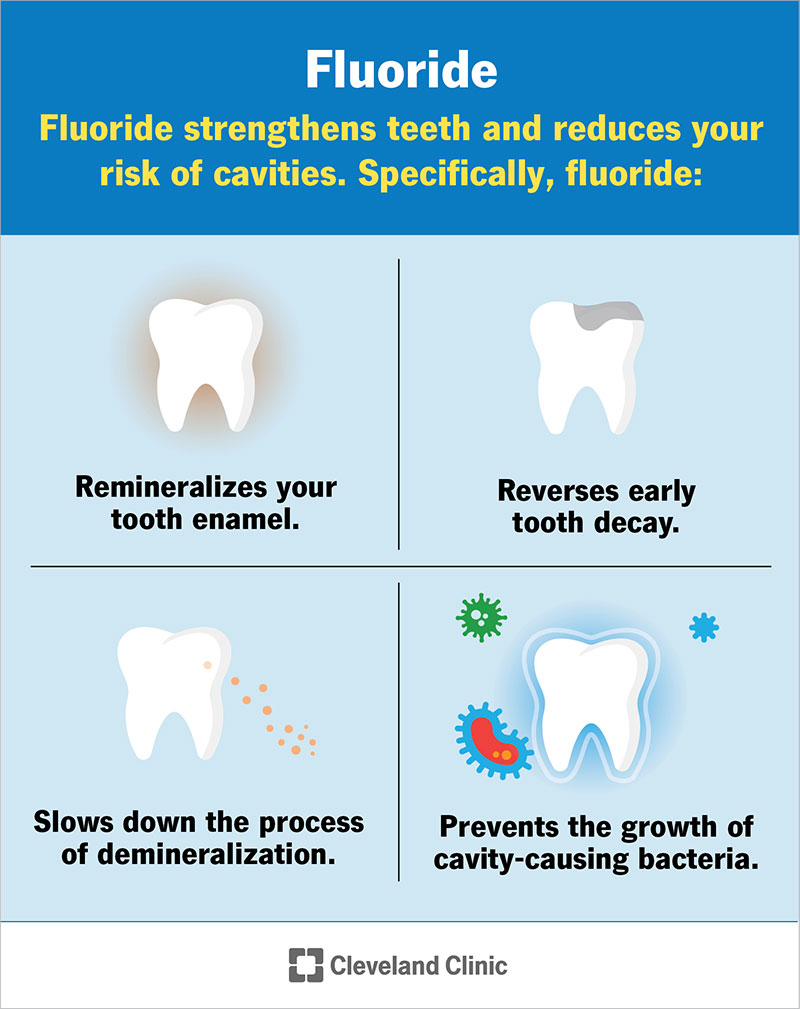Fluoride, a mineral that occurs naturally in many foods and water, helps prevent tooth decay. Fluoride reverses early decay and remineralizes your tooth enamel. While fluoride can be harmful in large quantities, it’s difficult to reach toxic levels due to the low amount of fluoride in over-the-counter products like toothpastes and mouth rinses.
Advertisement
Cleveland Clinic is a non-profit academic medical center. Advertising on our site helps support our mission. We do not endorse non-Cleveland Clinic products or services. Policy

Fluoride is a naturally occurring mineral found in many foods and water. In dentistry, healthcare providers use fluoride to strengthen teeth and reduce the risk of cavities.
Advertisement
Cleveland Clinic is a non-profit academic medical center. Advertising on our site helps support our mission. We do not endorse non-Cleveland Clinic products or services. Policy
Every day, your enamel (the protective outer layer of your tooth) gains and loses minerals. You lose minerals when acids — formed from bacteria, plaque and sugars in your mouth — attack your enamel. (This process is demineralization.) You gain minerals — like fluoride, calcium and phosphate — when you consume food and water that contain these minerals. (This process is remineralization.)
Tooth decay is a result of too much demineralization without enough remineralization.
Dental fluoride helps prevent tooth decay by making your enamel more resistant to acid attacks. It also reverses early decay.
Many foods and water contain fluoride. You can also purchase fluoride toothpaste and mouthwash. You can buy low-strength fluoride mouthwash over the counter. Stronger concentrations in liquid or tablet form need a healthcare provider’s prescription.
A dentist can also apply fluoride to your teeth in the form of:
Infants and children between the ages of 6 months and 16 years need an appropriate amount of fluoride. Developing teeth benefit from fluoride just as much as teeth that have already erupted (grown in).
Advertisement
The American Dental Association (ADA) recommends watching the intake of too much fluoride in infants and young children. The ADA specifically recommends avoiding reconstituted liquid formulas, such as liquid concentrate or powdered baby formulas that require mixing with fluoridated water.
Instead, the ADA recommends breast milk, ready-to-feed formula or prepared formula mixed with fluoride-free water. These recommendations are to guard against enamel fluorosis — faint white streaks that can appear on tooth enamel during a child’s developmental years, even before the teeth erupt through the gums.
For young children, the ADA also recommends:
Yes, adults can benefit from fluoride, too. You might especially benefit from fluoride if you have:
A dentist or hygienist can give you a fluoride treatment during a routine dental exam or cleaning. They’ll apply a fluoride gel, foam or varnish to your teeth. Typically, a fluoride treatment takes less than five minutes.
Fluoride strengthens teeth and reduces your risk of cavities by approximately 25%.
Specifically, fluoride:
When used properly, fluoride is safe and effective. But it can be hazardous at high doses. (The “toxic” dosage level varies based on a person’s weight).
If you’re a parent, it’s important to supervise your child’s use of fluoride. Here are some helpful tips:
It’s very difficult to reach dangerous fluoride levels due to the low levels of fluoride in over-the-counter products. But if you have concerns, talk to your dentist, pediatrician or primary care provider (PCP).
Advertisement
The most common side effect of fluoride is fluorosis (fluoride-induced tooth discoloration). People with fluorosis develop spots on their teeth that can range from light white to dark brown. These spots typically occur during tooth development, usually in children under the age of 6.
Fluorosis most often results from consuming naturally occurring fluoride, like that found in well water. If you have well water, testing a sample can help determine how much fluoride is in your water.
You can’t brush fluorosis away, but a dentist might be able to use special bleaching methods to address the issue. If professional whitening doesn’t work, you can opt for dental bonding or porcelain veneers.
The answer to this question depends on your unique oral health needs. Many people benefit from fluoride treatments every six months. If you’re prone to cavities, you might benefit from more frequent treatments. To find out what’s right for you, talk to your dentist.
The optimal level of fluoride is 0.7 parts per million. This is the amount in public water supplies in the communities that have fluoridated water.
Get in touch with your local health department or water supplier. They can tell you how much fluoride is in your water. In the United States, about 74% of people with public water supplies have adequate levels of fluoride in their water.
Advertisement
When you consume fluoride, your gut absorbs it, and your bones and teeth store the rest. Any unabsorbed fluoride leaves your body when you pee.
The benefits of using dental fluoride include stronger enamel and better protection against tooth decay. But large amounts of fluoride can be toxic. It can also result in fluoride-induced tooth discoloration (fluorosis). Ask your dentist how to get the right amount of fluoride.
Yes. When used properly, fluoride is one of the best ways to strengthen your enamel and reduce your risk of cavities. Ask your dentist for product recommendations and how often you should get fluoride treatments.
Fluoride is a mineral that occurs naturally in water and many foods. Dentists harness the power of fluoride to strengthen your tooth enamel and reduce your risk of cavities. While large amounts of fluoride can be dangerous, it’s very difficult to reach toxic levels with properly fluoridated water and over-the-counter products that contain fluoride. Talk to your dentist to learn more and find out if you need professional fluoride treatments.
Advertisement
Dentistry plays an important role in oral health. Cleveland Clinic’s experts can design a personalized plan that will keep you smiling for the long haul.

Last reviewed on 02/09/2023.
Learn more about the Health Library and our editorial process.